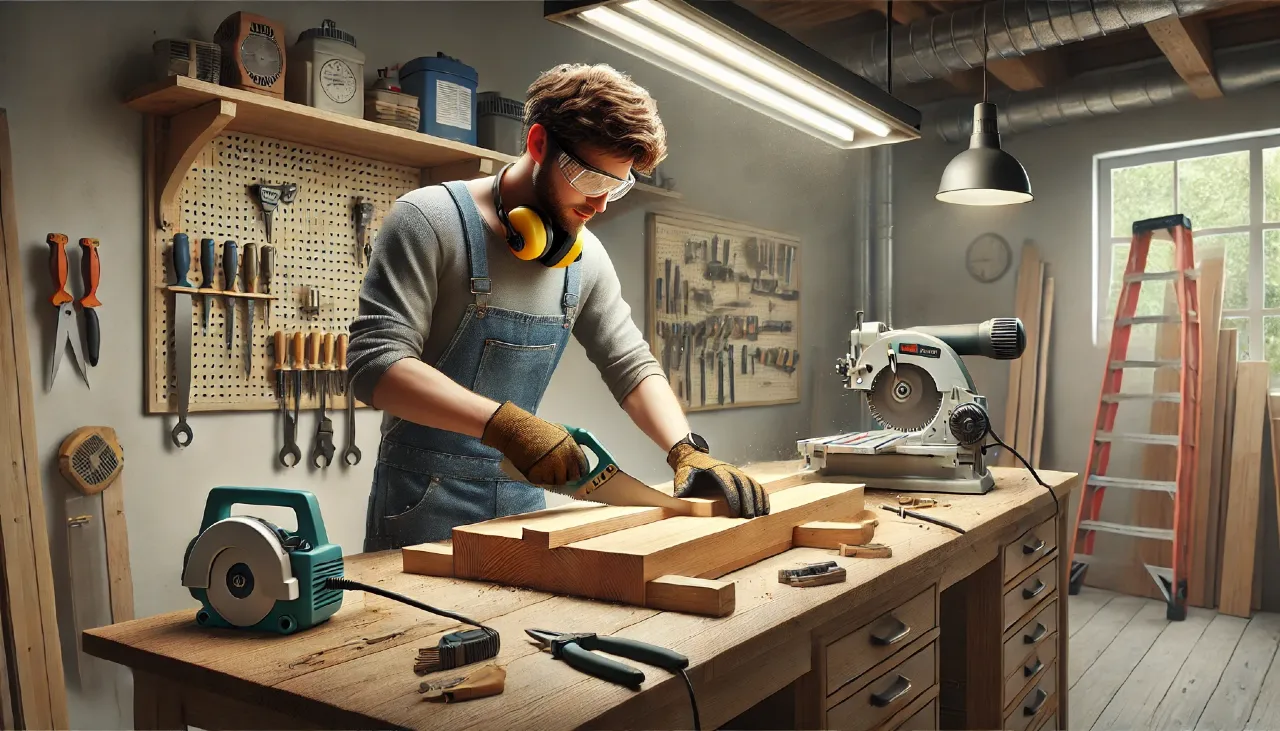Carpentry is a rewarding skill, but it involves working with sharp tools and heavy materials, making safety a priority. Whether you are a beginner or an experienced woodworker, following the proper carpentry safety tips ensures you stay safe while crafting your next project. In this guide, we’ll cover essential woodworking safety guidelines, the necessary safety gear, and how to avoid common hazards in a carpentry workshop.
Importance of Safety in Woodworking
Before diving into specific carpentry safety tips, it’s important to understand why safety is critical in woodworking. Woodworking tools, especially power tools, can cause serious injuries if not handled correctly. Following safe carpentry practices reduces the risk of accidents, protects your health, and ensures a smooth and enjoyable woodworking experience.
Essential Carpentry Safety Rules
Every beginner should familiarize themselves with the following essential carpentry safety rules before starting any project:
- Wear Personal Protective Equipment (PPE): Always wear the appropriate woodworking safety gear, including safety goggles, gloves, hearing protection, and a dust mask.
- Inspect Tools Before Use: Ensure that all tools are in good working condition. Never use a tool with dull blades or damaged parts.
- Keep Your Work Area Clean: A cluttered workshop can lead to accidents. Maintain a tidy and organized space to avoid tripping hazards.
- Follow Instructions for Tools: Whether using a hand tool or a power tool, always follow the manufacturer’s instructions for safe operation.
- Never Rush: Rushing increases the likelihood of making mistakes. Take your time and maintain a steady pace when working with tools.
Carpentry Safety Equipment
Investing in proper carpentry safety equipment is the first step to staying safe in the workshop. Essential personal protective equipment for carpentry includes:
- Safety goggles: Protect your eyes from wood chips, sawdust, and debris.
- Gloves: Use work gloves to protect your hands from sharp edges and splinters.
- Hearing protection: Prolonged exposure to loud tools like saws and drills can cause hearing loss, so wear earplugs or earmuffs.
- Dust mask or respirator: Protect your lungs from inhaling fine dust particles generated by cutting, sanding, or sawing wood.
- Steel-toe boots: These provide protection from falling objects or heavy wood materials.
Common Carpentry Safety Hazards
Understanding the most common hazards in carpentry helps prevent accidents. Some of the most frequent carpentry safety hazards include:
- Power tool accidents: Injuries from saws, drills, and sanders are common in woodworking. Follow proper power tool safety tips for carpentry to avoid cuts and other injuries.
- Flying debris: Wood chips, nails, and dust can fly toward your face while cutting or hammering. Wear safety glasses to avoid eye injuries.
- Falling objects: Improperly stacked wood or tools can fall, causing injury. Always secure materials and keep heavy objects on lower shelves.
- Slips and falls: Sawdust on the floor can make the workspace slippery. Regularly sweep your workspace to maintain a safe environment.
- Inhalation of dust: Fine wood particles in the air can cause respiratory issues over time. Use a dust control system and wear a mask or respirator.
Woodworking Safety Guidelines
Following proper woodworking safety guidelines can help you stay safe and avoid injuries in the workshop. Here are some key tips:
1. Proper Handling of Woodworking Tools
Knowing how to handle your tools correctly is essential. For hand tool safety in woodworking, always:
- Use sharp tools to avoid excess pressure, which can cause slipping.
- Keep both hands on the tool when cutting or chiseling.
- Use clamps to secure your workpiece, preventing it from moving while you work.
For power tool safety tips, consider the following:
- Ensure that tools are turned off and unplugged when not in use.
- Never remove safety guards from tools like saws and drills.
- Keep cords away from cutting areas to avoid accidental damage.
2. Safety Tips for Using Saws
Saws are some of the most dangerous tools in carpentry. To avoid accidents:
- Always wear eye protection when using saws to prevent injury from flying wood particles.
- Make sure the saw blade is sharp and properly adjusted.
- Use push sticks or guides to keep your hands away from the blade when cutting narrow pieces.
- Never attempt to free a jammed blade while the saw is running.
3. Woodworking Dust Control Safety
Dust control is critical in woodworking because inhaling fine wood particles can lead to respiratory problems. Here are a few woodworking dust control safety tips:
- Use a dust collection system or vacuum to reduce airborne dust.
- Wear a dust mask or respirator, especially when sanding or cutting large amounts of wood.
- Ensure your workshop is well-ventilated to keep the air clear of harmful particles.
Preventing Injuries in Carpentry
Preventing injuries is a top priority for every woodworker. Here are some strategies to reduce the risk of accidents in the workshop:
1. Beginner Woodworking Mistakes to Avoid
As a beginner, it’s easy to make mistakes that can lead to accidents. Here are common beginner woodworking mistakes to avoid:
- Using dull tools: Dull tools require more force, increasing the risk of slipping and injury.
- Ignoring tool maintenance: Proper maintenance ensures that tools function correctly and safely.
- Not wearing protective gear: Always wear your carpentry safety equipment even for small tasks.
- Rushing through tasks: Slow down and focus on precision over speed.
2. How to Avoid Accidents in Carpentry
To minimize accidents in carpentry, follow these safe carpentry techniques for beginners:
- Plan your cuts carefully: Measure twice and cut once to avoid mistakes.
- Focus on balance and stability: Always make sure your workpieces are securely fastened before cutting or drilling.
- Keep your fingers clear: When using saws or drills, keep your hands and fingers a safe distance from the blades or bits.
Ladder Safety in Carpentry
Using ladders in carpentry requires special attention. Improper ladder use is a common cause of accidents. Here are a few ladder safety tips:
- Inspect the ladder: Ensure it’s stable, and all parts are in good condition.
- Set it up correctly: Place the ladder on even ground and lock the braces.
- Maintain three points of contact: Always have two hands and one foot or two feet and one hand on the ladder.
- Don’t overreach: Avoid leaning too far to one side while on the ladder.
Fire Safety in Woodworking Shops
Working with wood generates fine dust that can be a fire hazard. In addition, many finishes and stains used in woodworking are flammable. To ensure fire safety in woodworking shops:
- Store flammable materials properly, away from heat sources.
- Keep a fire extinguisher readily accessible in your workshop.
- Regularly clean dust from surfaces, as accumulated dust can ignite from sparks.
- Avoid smoking in the workshop and always turn off tools when leaving the workspace.
Woodworking Safety Gear
Having the right woodworking safety gear is non-negotiable. Here’s a detailed look at essential safety equipment:
- Safety goggles: Prevents eye injuries from flying debris.
- Hearing protection: Essential when using noisy tools like circular saws and drills.
- Dust mask or respirator: Protects your respiratory system from dust and fumes.
- Work gloves: Protect your hands from cuts, splinters, and chemical burns.
- Apron or protective clothing: Wear a heavy-duty apron to protect your clothes and skin from sawdust, sparks, or sharp objects.
Carpentry Workshop Safety
Setting up a safe workshop is key to maintaining a productive and accident-free environment. Some important carpentry workshop safety considerations include:
- Organized tool storage: Keep tools stored safely when not in use to prevent tripping or falling hazards.
- Adequate lighting: Ensure your workspace is well-lit to avoid misjudging cuts or missing hazards.
- Emergency exits and equipment: Know the location of first aid kits and fire extinguishers. In case of an accident, you need quick access to help.
- Ventilation: Make sure your workshop is well-ventilated to reduce exposure to harmful fumes from finishes and solvents.
Hearing Protection for Carpenters
Long-term exposure to the high decibel levels of power tools can cause permanent hearing damage. It’s important to use hearing protection for carpenters, such as earplugs or earmuffs, especially when using loud tools like saws, routers, and sanders.
Eye Protection for Carpentry
Eye protection is one of the most basic but critical aspects of carpentry safety for beginners. Wearing safety glasses or goggles helps prevent injuries from wood chips, splinters, and sawdust. Ensure your eyewear meets ANSI (American National Standards Institute) standards for impact resistance.
Safety Tips for Carpentry Tools
Carpentry tools, both hand and power, pose risks if not used properly. Some key safety tips for carpentry tools include:
- Keep blades sharp: Dull blades can cause tools to slip, increasing the risk of accidents.
- Use the right tool for the job: Don’t use tools for tasks they weren’t designed for.
- Maintain a secure grip: Hold tools firmly and always cut away from your body.
- Unplug power tools: Disconnect power tools when changing blades or bits to prevent accidental starts.
How to Stay Safe in Carpentry
To sum up, staying safe in carpentry boils down to following basic rules, using the right equipment, and maintaining an organized workspace. Key takeaways include:
- Always wear personal protective equipment.
- Keep your workspace clean and clutter-free.
- Follow manufacturer’s instructions when using tools.
- Take your time and avoid rushing through tasks.
- Regularly inspect your tools for damage or wear.




